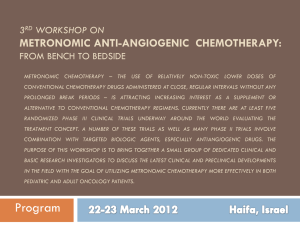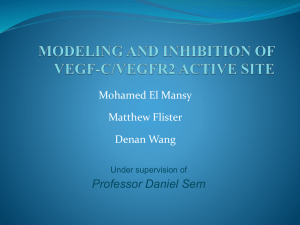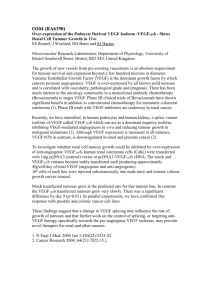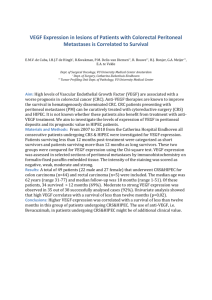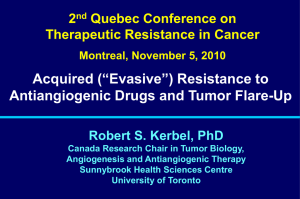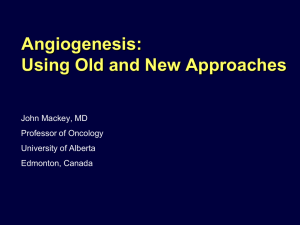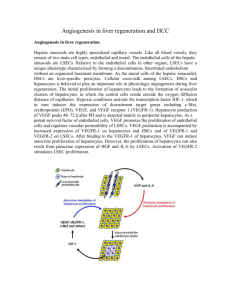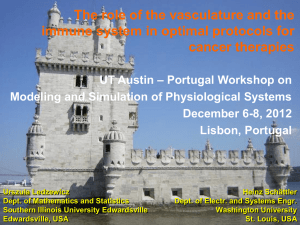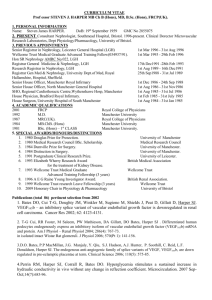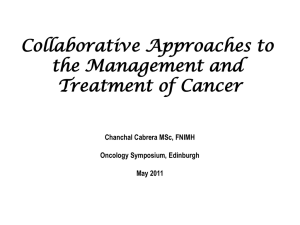Angiogenesis and Angiogenesis Inhibition: Strategies and Prospects
advertisement
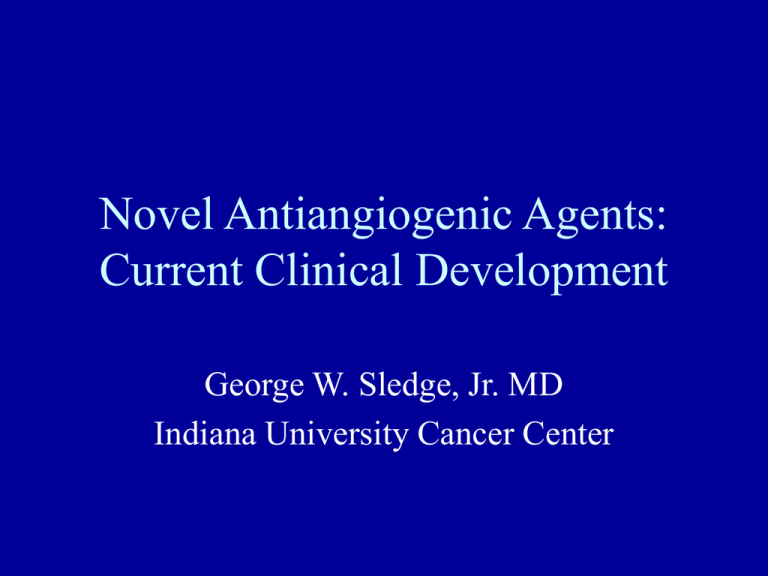
Novel Antiangiogenic Agents: Current Clinical Development George W. Sledge, Jr. MD Indiana University Cancer Center Antiangiogenic Therapies: Potential Targets • Block pro-angiogenic molecules (e.g., VEGF) • Add anti-angiogenic regulators (e.g. angiostatin, endostatin, TSP-1) • Inhibit stroma-degrading enzymes (e.g., MMPIs) • Target vascular antigens (e.g., avb3 integrin) • Attack pericytes VEGF Is a Key Mediator of Angiogenesis Upstream activators of VEGF synthesis Downstream signaling pathways Methods of VEGF Signal Inhibition Ligand sequestration: MAbs, soluble receptors Indirect - inhibition of growth factors, HER-2 Receptor blocking Mabs, soluble receptors p85 ras GRB2 PLCg Inhibit receptor production; ribozymes Tyrosine kinase inhibition: TKIs SOS Inhibition of tyrosine phosphorylation and downstream signaling inhibition Transcription factor inhibition rhuMAb VEGF (Recombinant Humanized Monoclonal Antibody to VEGF) Humanized to avoid immunogenicity (93% human, 7% murine). Recognizes all isoforms of vascular endothelial growth factor, Kd= 8 x 10-10M Terminal half life 17-21 days Efficacy of rhuMAb VEGF Dose (mg/kg) 3 10 (n=18) (n=41) CR 0 1 PR 1 3 Stable at 22 weeks 2 4 CR/PR/SD at 22 wks. 3 8 Rx > 1 year 0 3 20 (n=16) 0 1 2 3 - Refractory Metastatic Disease Eligibility: - One or two prior therapies OR - Relapse within 12 months of adjuvant anthracycline and taxane - No CNS mets R A N D O M I Z E Accrual goal: 400 patients Capecitabine + rhuMAb VEGF Capecitabine Toxicities of Anti-VEGF Therapy • • • • • Hemorrhage (lung cancers) Hypertension (anti-VPF) Headaches/migraines Clots (maybe) Proteinura/nephrotic syndrome Intracellular Signaling Pathways Activated by VEGF Binding to VEGFR2 ZD6474 SU11248 Potently Inhibits VEGFR, PDGFR and Kit in Biochemical and Cellular Assays Receptor Biochemical Ki (M) Flk-1/KDR PDGFR c-kit FGFR EGFR Flt-3 0.009 0.008 ND 0.83 > 100 ND Cellular IC50 Receptor Ligand-dependent Phosphorylation (M) Proliferation (M) 0.01 0.01 0.01 ND ND 0.25 0.004 0.031 0.01 0.70 8.9 0.01-0.1 Anti-Flt-1 Ribozyme Uppercase = ribonucleotides; lowercase = 2’-O-methyl ribonucleotide; B = inverted 2’-deoxyribose abasics; s = phosphorothiolate linkage; u4 = 2’-C-allyl nucleotide. Sandberg JA et al. J Clin Pharmacol. 2000;40:1462-1469. The Problem With AntiAngiogenic Therapy: Resistance Mechanisms of Resistance • • • • • • • Endothelial cell heterogeneity Tumor heterogeneity Impact of tumor microenvironment Compensatory response to hypoxic insults Re-growth independence from angiogenesis Vascular mimicry Vasculogenesis Thwarting Resistance • Use chemotherapy with anti-angiogenic intent - ‘metronomic therapy’ • Combine with chemotherapy • Combine multiple anti-angiogenics • Combine with other biologics • Use anti-angiogenics as targeted therapy • Use anti-angiogenics in adjuvant setting Use Standard Therapies With Anti-Angiogenic Intent • Concept: – Standard chemotherapeutic agents have potent anti-angiogenic activity – We use them poorly from an antiangiogenic standpoint – Metronomic therapy (chronic low-dose chemotherapy) overcomes resistance Metronomic Therapy in the Clinic: Colleoni • Study design: Phase II trial of CTX 50 mg p.o. qd + MTX 2.5 mg p.o. D 1,2 qwk. • Patient Characteristics: 64 MBC pts, 32 with 1 prior regimen, 20 with 2+ prior regimens, 41 with adjuvant regimen • Results: CR + PR = 19%; CR + PR + SD >24 wk = 31.7 Combine anti-angiogenic agents with standard chemotherapy • Concept: – Chemotherapeutics are anti-angiogenics – Pro-angiogenic factors protect tumor endothelium – Preclinical support for combinations of anti-angiogenics’s with CT E2100 Eligibility: - No prior Rx for mets - Adjuvant taxane if >12 mos. Exclusion: - Her-2 + - CNS mets - Proteinuria - Uncontrolled HTN Accrual goal: ~690 R A N D O M I Z E Arm A: Paclitaxel + rhuMAb VEGF Arm B: Paclitaxel Combine anti-angiogenic agents with each other • Concept: – Angiogenesis is a redundant process – Tumor progression is associated with angiogenic growth factor progression--> resistance to individual agents – Preclinical evidence of combinatorial benefit with anti-angiogenics Combine anti-angiogenic agents with other biologics • Concept: – Angiogenesis is under control of numerous polypeptide growth factors – Targeting growth factor receptors decreases angiogenesis – Potential for additivity/synergy Mean Ascites Grade (1 thru 4) Effect of Anti-angiogenic Therapy on Mice With Colon Cancer Carcinomatosis 4 3 2 * 1 * ** 0 Control DC101 C225 DC101/C225 *P < 0.001 relative to Control, **P < 0.001 rel. to DC1 Use anti-angiogenic therapy as targeted therapy • Concept: – Antiangiogenic therapy is viewed as general therapy – Resistance to specific agents implies specific resistance phenotypes/genotypes – Target therapy to specific tumors Use anti-angiogenic therapy as adjuvant therapy • Concept: – Anti-angiogenic therapy has not eliminated drug resistance – Pro-angiogenic factors increase as tumors progress – Resistance is a function of tumor size/mutation rate – Treat tumors before they become resistant Adjuvant Angiogenesis: Requirements • • • • • • Chronic safety Combinatorial safety Chronic dose maintenance Large Proof-of-Concept trials Disease-specific rationale Proof of efficacy in advanced disease (???) BMS-275291 • Potent, peptidomimetic inhibitor of MMPs – rationally designed to spare sheddases • metalloproteinases which process TNF-a, TNF-aRII • Daily, oral, outpatient regimen • Expectations – No dose-limiting arthritis – Complementary efficacy to chemotherapy BMS-275291 Adjuvant Pilot Patients with Stage I-IIIa breast cancer receiving standard therapies randomized (2:1) to: • BMS-275291 1200 mg/day x 12 months • Placebo daily x 12 months • All patients may continue open-label for one additional year; Accrual goal = 120
